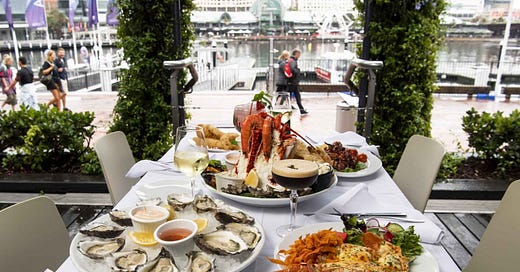After a look under the bonnet of Stockholm’s long-standing and successful road price, we are back home in Oz for a short visit.
I have booked us in for lunch at Nick’s Seafood Restaurant in Darling Harbour Sydney. (Nicks, as we will call it.) I have never been here myself but have heard good things.
While they are getting our lunch ready, we can go over the different price tools we have met so far in our search. Then I will tell you why we are at Nicks.
Some time ago we set out to find the cause of congestion – which turned out to be over-load. This discovery set us on the path to find the price tool that would prevent over-load and restore free-flow speeds on congested roads.
Along the way we have seen several price tools in action.
The hammer
First, we looked at Pigouvian charges in London and Italy. If this type of price were a tool, it would be a hammer that enables you to whack the consumption of some harm. Want to drive into London – $27, whack. Ouch.
Here is BC’s Pigouvian carbon tax hammer bashing down petrol consumption to reduce emissions.
The Pigouvian hammer is not a precision instrument. But with harms like local pollution it does not really matter how hard you hit. Not quite hard enough? – Give it another whack. Bit too heavy? Did you reduce pollution too much? Never mind.
Some centres with an over-load problem have opted for a Pigouvian price hammer for their congestion charge and try and whack every trip across the day. The problem is an all-day charge also whacks the off-peak and reduces consumption when the road is already in free flow (or the parking system is half empty).
We need a tool that will only function during periods of over-load and then, rather than bludgeoning the load, a tool to carefully reduce it below maximum in a calibrated manner.
Walter Gaylord tapping a maple sugar tree
The drill
The other main price tool we have seen is the revenue-raising asset fee.
If this price were a tool, it would be like the drill you use to bore into the sugar maple tree to draw off the sweet sap.
You must be careful when drilling maple sugar trees. (Walter is probably using an 11mm bit.) Drill the holes too wide, too deep, too near last year’s hole, drill too many holes in the one tree or drill too small a tree and you will end up with no tree and no maple sugar.
So, it is with asset fees. If you drill too hard and impose too high a fee you reduce the amount you recover. This is what we saw in Seattle where the too-big fee left the revenue bucket half full. We may see the same thing happen in New York.
This price also runs across the day but only drip, drip, drip. That is not much use to us. We need something with a bit more grunt, something that will make a difference to the load.
Stockholm
Then we went to Stockholm and got a glimpse of a completely different type of price. There the fees wake up at breakfast, rise sharply to the top of the M-shaped tariff, fall in the middle of the day, rise the M again, fall once more and then switch off completely in time for tea.
If the Stockholm-style price were a tool, it would be a spanner that enables you to progressively torque up the fees to the peaks and then ease them off on either side when the load subsides.
A rubber-coated spanner for working on electric vehicles
What shall we call this spanner price?
So, what is the name of the spanner price Stockholm seems to be using? Does it have a fancy name in economics like Pigouvian?
Not as far as I can tell, which is strange because this type of price – though not much used for roads and parking – is widely used across many other domains.
Perhaps it has no name because it is so self-effacing, so ubiquitous and so uncontroversial it is almost invisible. You could argue it is not a price at all as it does some of its best work when no one pays, and no revenue is raised.
Still, for this Guide we need a name that distinguishes it from our other two price types. Ideally, a name that reminds us of the price purpose.
A purpose-based name rules out calling it a spanner price or, as we did earlier, a thermostat price. That is how the price behaves, but it does not tell us what it is trying to achieve. It also knocks out the name often used by electricity people – the time-of-use price. It is characteristic of this type of price that fees vary by time of use, but that is what they do, not what they are for.
Another descriptive name used by some is ‘dynamic’ since the fees change across the day and are adjusted across the year. But dynamic also describes prices in the supermarket (and in many other domains) and they are dynamic for a completely different purpose. Calling the spanner price dynamic would risk misunderstandings about profiteering. Dynamic also sounds like it would be unpredictable, like tomorrow’s price for the Australian dollar.
At least these descriptive names are accurate, unlike another widely used name: demand-based pricing. This name contains a profound misdirection – like calling the mosquito-borne disease ‘bad air’ or malaria. The spanner price is not based on demand but supply. On the supply side there are only 2,500 spots on the road up for auction and the limited stock (maximum load) is what shapes the fee. In Stockholm not all the demand was met – all the drivers on the floor of the Exchange wanted to drive into the centre, but only some were prepared to pay $3 to do so.
Years ago, the term demand management was popular. This term describes an approach rather than a price, but it has the merit of implying that some demand will not be satisfied, but instead will be ‘managed’ – a euphemism for disappointed. However, it sounds a bit hit and miss – management is not a precision operation – and worst of all it sounds as if some Manager gets to decide who gets to drive into town. The spanner price does not have a manager but an Auctioneer who keeps taking bids until the bidders arrive at the clearing price – it is the buyers or drivers who decide what fee will restore free-flow.
Since the public domain lacks a good name for the spanner price, we will propose one and use it in the Guide. If we look closely at the spanner price, we can see that it loosens and tightens fees to head off any threatening over-load and it seeks to do so by influencing people’s behaviour. The fees are not intended to raise revenue or reduce consumption but influence behaviour. So let us call them behavioural fees.
Behavioural fees are widely used and one of the everyday applications is the deposit.
And that is why we are having lunch today at Nicks. When you look how Nick sets deposits you can see he is a master designer of behavioural fees. (I am hoping he is equally skilled with seafood.)
Here are some lightly edited highlights from Nicks terms & conditions:
Behavioural fees at Nick’s Seafood Restaurant
Length of stay
If your reservation is prior to 8pm on a Saturday Evening, a 2-hour time duration will apply. Reservations from 8pm – no departure time.
Time bands
Your deposit amount will be deducted from your final bill on the day.
Deposit will not be refunded if the restaurant receives less than 7-days notice of cancellation.
Your final numbers are required 72 hours in advance; if we are notified of a decrease in numbers up until 24 hours prior to your scheduled arrival time a $25 per head charge to the variance in numbers will apply.
If notification has not been received prior to your scheduled arrival time, then full payment will be required for any missing guests.
Large groups
All reservations with 40 or more guests will require full food payment along with your final guest numbers 72 hours in advance
Peak times
Melbourne Cup Day: No bookings will be confirmed without Full Pre-Payment. A 100% Cancellation Fee will apply after the 22nd of October. [9 – 16 days’ notice]
Christmas Day: The deposit amount of $100 is a holding deposit only per table, deposits will be processed if the restaurant receives less than 72-hour’s notice of cancellation.
New Year’s Eve: No bookings will be confirmed without Full Pre-Payment. A 100% Cancellation Fee will apply after the 17th December. [14 days’ notice]
The design of a behavioural fee
Based on these behavioural fees (and conditions) we can understand the loads at the restaurant.
Across the week:
Loads are light during the week except on Saturday evenings.
Peaks occur on Saturday evenings, so length of stay is limited to 2 hours to optimise throughput.
Maximum load occurs before 20:00. In the shoulder period after 20:00, the limit on stays is lifted.
In the run up to a booking, Nicks sends signals through fees and time bands (which we have given a name):
Confirmation: The first time-band ends ≤ 7 days to the booking. In this period deposits can be recovered.
Final Numbers. The next time-band ends at Booking minus 72 hours. During this period dropouts lose their deposit.
Last Exit: This time-band runs from 72 – 24 hours, In this period, any dropouts incur a charge of $25.
Last Day. Any dropouts in the final 24 hours must make full payment.
The heaviest loads are at the festivals of Melbourne Cup (November), Christmas and New Year’s Eve:
The 3 peaks have different intensities.
Christmas is the lower seasonal peak. There is no pre-payment, but you must put down $100 to reserve a table. However, you can pull out 72 hours before the fixed date and still recover your table deposit.
The Cup and New Year are the highest peaks as full pre-payment is necessary and if you pull out a fortnight before, there is no refund.
New Year is the highest peak as it has the longest minimum no-refund period.
There is some skilful behavioural fee design here including the dropout charge set at $25 and the different settings for different festivals – lots to see and consider – but here comes our lunch and we should give it our full attention.
We will get back to behavioural fee setting a bit later over coffee.










Great images, easy to access the data. Thanks.